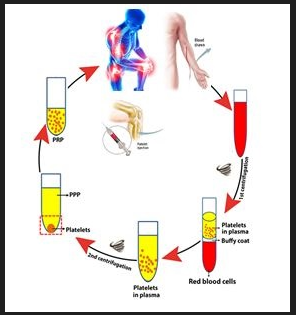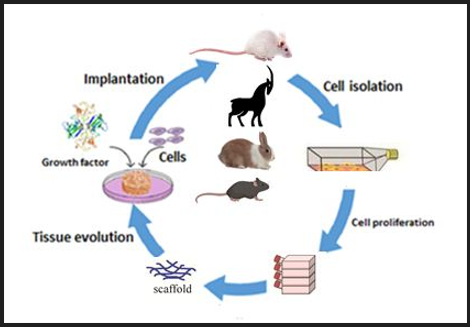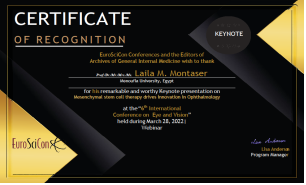Advances in
eISSN: 2572-8490


Short Communication Volume 8 Issue 1
Faculty of Medicine, Menoufia University, Egypt
Correspondence: Distinguished Prof. of Clinical Pathology, Chair, Stem Cell, Regenerative Medicine, Nanotechnology and Tissue Engineering (SRNT) Research Group, Faculty of Medicine, Menoufia University, Egypt
Received: July 11, 2022 | Published: July 25, 2022
Citation: Montaser LM. Could stem cell study in space avail patients and researchers on Earth? Adv Tissue Eng Regen Med Open Access. 2022;8(1):1-5. DOI: 10.15406/atroa.2022.08.00127
With a growing proportion of people that are 65 years and older, age-linked cases like stroke, cancer, mentality, and degenerative illness lead to an escalating health load in the world. Regenerative medicine researchers are frequently acting to progress stem cell-based remedies that could assist cure patients with these situations. However, stem cell-based treatments require great numbers of stem cells that are hard to produce. The outgrowth media utilized in modality cell cultures do not supply perfect growth conditions, and even if stem cell amplification is effective, it is usually a slow operation. This triggers it defying tolerating stem cells into the big numbers required for clinical implementations. Cell cultures in a laboratory on Earth cultivate in a single layer –a 2D design– as gravity causes precipitation and the culture medium pushes downward on the cells. As an outcome, scientists want a template or scaffold to boost the up growing tissue in 3D tissue engineering and regenerative medicine are strategic zones of concentrate for the International Space Station (ISS) Lab. In a weightless milieu as space, cells could display selectively unstrapped expansion and gather into congregation 3-D builds. This could open the prospect of “macro-tissues” –organs – may to be created from these 3-D cell structures. Beside, in the trust of concluding several of the mysteries of how stem cells expand, split and compose into tissues. Aspire to stem cell research to be the zone that could be progressed in microgravity. Hope for the ISS National Lab to fit as an entirely realistic feasible practical robust down-to-earth space laboratory for workable and potentially safe to grow mesenchymal stem cells (MSCs) for potential future clinical applications on Earth.
Keywords: Stem cell, space, regenerative medicine, scaffold, 3D tissue engineering, International Space Station, microgravity, MSCs, PRP
In 2009, a research lab was established in the Clinical Pathology Department at Menoufia Faculty of Medicine. Stem cells, regenerative medicine, nanotechnology and tissue engineering (SRNT) research group was started by a group of scholars at Menoufia University in Egypt led by Prof. Laila Montaser Chair Emeritus, Chair, Founder leader of Clinical Pathology Department; as the Chair of the group (Inaugural holder of the SRNT Chair). SRNT research group is involved in investing in an animal facility to conduct preclinical efficacy studies and some clinical researches for cell-based therapies. This research group is involved in treatment development1–3 and is investing in an animal facility to conduct preclinical efficacy studies for cell-based therapies.4–10 The SRNT business paradigm is to harness both scientists and clinicians in evolving technology while matching with healthcare distribution suits. The SRNT group has begun later on a Nano-biomaterial-based cell culture.
In 2014, Blaber and colleagues11 reported that to declaim the requirements for stem cell and other cell science research on the ISS, NASA has advanced the novel Bio culture System that will permit researchers to start and perform on-orbit quizzes that astronauts will be capable to watch and react with during the trajectory of cell cultivations. This cell culture capacity joined with progressing technologies for molecular biology and on-orbit estimation of gene expression and other agents that are now arriving online get the ISS National Laboratory a footstep near to becoming a perfectly workable space laboratory for developing space biological sciences. Space is a tall track to start to understand about human tissues, still scientists have their glances practiced at the stars.
Laila Montaser and her SRNT group researching stem cell
Before looking to the space, Montaser and her team have to throw highlights on their cornerstone overwork experimental labor and present their innovative technologies using stem cells and Nano scaffolds for regenerative medicine and tissue engineering applications on earth.
Advanced technologies are authorizing regenerative medicine via the presentation of novel, extra precise, comfortable-to-utilize agents. So, one of the utmost pertinent inventions is bound to the proliferation of autologous cells for transplantation.
Montaser is handling to inspirit a century-old blood-derived therapy for use as a therapy for the Osteoarthritic patients. Platelet-rich plasma (PRP) rich in growth factors from patients of Osteoarthritis used as a therapy for them (Autologous).1–3 The overall work-flow involved in the cure of the Osteoarthritic patients using blood plasma is schematically represented in (Figure 1).

Figure 1 Schematic drawing representing the workflow of study.
Human whole blood is produced by venipuncture of blood from the patient and then subject to two sequential centrifugation steps (i.e. separation and concentration). The first centrifugation separates pellet plasma, leukocytes, and platelets from the erythrocytes. The second centrifugation collects concentrated platelets in a small volume of plasma (designated as PRP). Activation of the prepared PRP is applied by CACl2 then rapidly administer to the patient (Autologous) by injection in the knee.
The success story – Putting technology into practice, which was previously presented in Montaser editorial 2016 published in the journal of Adv Tissue Eng Regen Med, titled "Regenerative Medicine and Tissue Engineering-Driven Innovation of Medical Science and Technology." 1–3 The story started with justifications of Laila Montaser nomination by the Council of Menoufia University, Egypt to TWAS prize 2016 in Medical Sciences of the World Academy of sciences for the advancement of science in developing countries and also to the Award of Nano Science Research Excellence 2016 (NML Researcher Award for outstanding researcher in Nanotechnology). The justifications completed with the Success Story - Putting Technology into Practice as the M.Sc. of Clinical Pathology, which was discussed in the February 7, 2016 entitled: “Platelet-rich plasma preparation applications in knee osteoarthritis” under Montaser supervision as the main supervisor and principal investigator who selected the subject of the research, the jury board had recommended the adoption of the thesis and for being a fabulous scientific breakthrough with 92.8% success rate for the first time in Egypt, addresses the Faculty Council on 21 February 2016 to put into clinical application in cases of knee Osteoarthritis and the practical application of this method. This leading M.Sc. thesis which started in Feb. 2013 and terminated in Feb. 2016 was responsible for the spread of this new concept and the large number of the research papers on pioneered application of platelet-rich plasma (PRP) procedure in a series of applications in regenerative medicine at our Department of Clinical Pathology and in many Clinical Departments at our Faculty of Medicine.
The regenerative medicine market is accelerated to a great degree by the emergence of stem cell technology. Sure, stem cells are catching great attentiveness in the regenerative medicine scope. More than one decade prior, Montaser and colleagues isolated MSCs and implemented Nano-biomaterial-based cell culture to apply in experimental animal models with many diseases5–6. Schematic of MSCs isolation is symbolized in Figure 2.

Figure 2 Schematic of the isolation of mesenchymal stem cells and implementation of Nano-biomaterial-based cell culture in experimental animal models with many diseases.
In this regard, Montaser presents a Mesenchymal Stem Cell Preparation Protocol where MSCs are isolated under defined culture conditions as per the protocol standardized and optimized in her lab.12 The objective is to show an ideal and exact lab technique in preparing MSCs which could be a paradigm option to handle. The aim of this manuscript is to urge ISS National Lab to prove it as a fully pragmatic handy actual potent down-to-earth space laboratory for feasible and prospectively credible to cultivate MSCs for chance future clinical enforcement on Earth.
Laila Montaser researching stem cell during the COVID-19 pandemic
In 2020-2021, according to Montaser five articles12–16 published in scientific peer-reviewed journals, where in the 1st one13 Montaser declared that more than twenty years ago, at the start of the millennium 2021, if the initiative of Montaser had been carried out at that premature era to set up a top-scale progressed center for stem cells and regenerative medicine at the Menoufia Faculty of Medicine, Menoufia University would have been the head-most of its type at that timing, not only in Egypt but in the Arab world and North Africa. Also, since more than eleven years in the year 2011, if Montaser’s initiative, her innovative, pioneering and fronting motif, was executed to set an entrepreneurship center at Menoufia University to insert entrepreneurship education in Egypt, Menoufia University would have be, since then, a beacon of science and innovation in the core of Egypt, who lighting sparkles not only in Egypt alone but also in the all Arab world and maybe worldwide. Then Montaser clarified that anyhow, the rapid advancements in the area of stem cell research have the potential to make Egypt an international capital of stem cell research therapy as Egypt has the capability to share in an extra recent stem cell research due to the robust spread of pharmaceutical and biotechnology segments. While the 2nd paper14 hypothesized that plasma from recovered patients proposal as a therapy for new COVID-19 patients, whereas the last three12,15–16 supposed that blood derived MSCs generated from the critically ill novel COVID-19 patient itself (autologous) suggested as a treatment for him. So, her point of view could mark an up-to-date medicinal strategy.
Laila Montaser gained twenty seven respectable Certificates of Appreciation from successfully presenting a series of forty three esteemed conferences online 27/43 (62.8%) through the era of COVID-19. The Certificates were presented in appreciation of an outstanding University Professor for her devoted and untiring endeavors to educate scientific society and public awareness on the COVID-19 pandemic, for her ideal command in leadership her University to achieve their role in society, for her relentless modality to push a quality tactic, and culture to act and for doing as role sample to all. Her diverse perspectives, notions, and viewpoints may provide extra innovation and best resolution. Her path breaking insights may open up a new era in stem cell research.17,18
The following three images as selective samples belong to the Certificates of Appreciation19–21 for keynote presentations about the state of art innovation and creativity in stem cell technology and applications in regenerative medicine and tissue engineering were awarded to Prof. Laila Montaser, as Figure 3 is a Keynote Certificate of Recognition awarded to her from 4th International Conference on Eye and Vision 2022, March 28-29, London, UK for her remarkable and worthy keynote display titled "Mesenchymal stem cell therapy derives innovation in Ophthalmology", also, Figure 4 is a Certificate of Recognition awarded to her from 14th World Congress on Stem Cell Research 2022, March 10-11 as a webinar, for her phenomenal and deserved keynote oral show on "Mesenchymal Stem Cell-Derived Exosomes as a Novel Technology in Regenerative Medicine", and lastly Figure 5 is a Keynote Speaker Certificate from Global Webinar on Stem Cell, Nov 11-12, 2021 also for her extraordinary and valuable oral offer entitled "Stem Cell: A Journey into Innovative Frontiers".

Figure 3 Keynote Certificate of recognition awarded to Prof. Laila M. Montaser from 4th Int. Conf. on Eye and Vision 2022, March 28-29, London, UK.
Vickers and Wen22 stated that the reconnaissance of space is a major pushing force of numerous persons for causes of human interest and destiny. Progress in stem cell technology and information could assist to conquer the main hurdle forced by cosmic radiation on astronaut health. Stem cell treatments have thorough published notarial proof of phase 1-3 experiments ratifying to their security and preparatory effectiveness in numerous medical cases. Translational research proposes physical homeostasis can be realized by equilibrium of stem cell renovation with cosmic radiation degradation. They proposed stem cell methods provide an opportunity to maintain health in the space environment against the damaging effects of cosmic radiation. The extreme harmful ionizing radiation for astronauts is galactic cosmic rays (GCR) and solar particle events (SPE) of x-rays and gamma rays,23 with outstanding flow inclusive demos of the bulk of this problem.24,25 MSCs are multipotent cells that make a significant service in the operative of immune cells and in fostering tissue reform and renovation.26 Adult tissues include just little numbers of stem cells–it is thought that smaller than 1% of cells in a specific organ are stem cells.27 The growth media utilized in criterion cell cultures does not supply idealistic growth situations.28
Scientists29 explained that they are employing weightlessness as an agent. Physical powers such as gravity impact how stem cells distinguish and how the making and rejuvenation of tissue is controlled. The scientists presume that due to the little gravity on board the ISS, novel created cells control themselves into 3D tissues without an extra matrix or else accessory constructions. In the future, the innovative operation can be utilized to create tissue transplants such as cartilage, novel cells of liver, lung, heart, or kidney in space from stem cells which are prepared from patients in a routine transaction.
Dhar30 concluded that the summation of microgravity and the raised ionizing radiation on the ISS causes stem cells to grow quicker - denoting researchers can monitor how they split and lifetime is without having to stay years.
Jones31 reported that about 250 miles above sea level, an unparalleled lab surrounds the globe. Here in little-ground orbit on the ISS, gravity’s pull is weak enough that things look to be weightless. These microgravity circumstances cause living matters - from human to organs and cells - to work differently than on Earth. Scientists from the University of Pittsburgh object to utilizing the ISS U.S. National Laboratory (ISSNL) to command biomedical research not available on ground and develop space-based bio industrialization. The scientists too plan trade chances and possible business paradigms for evolving a sustainable market for space-based bio processing. These concepts are significant for guaranteeing that novel remedies arrive to patients.
Abba Zubair,32 Guest Contributor, Mayo Clinic explained that stem cells do not expand widely in criterion 2D cell cultures, as this climate importantly diverges from the circumstances in which cells shoot within the body. Microgravity situations on the ISS authorize 3D cell outgrowth that extra-relatively epitomizes cell development in the human body. So, microgravity may supply a suitable milieu for stem cell culture and development. In their ISS U.S. National Laboratory study, they assessed the growth of human-derived MSCs in space for probable employment in clinical implementations on Earth and on future prolong-interval spaceflight assignments. The research determined the eventuality and integrity of developing MSCs in space for human clinical enforcement. The study team points out that MSCs mature in microgravity have an analogous outgrowth rate contrasted with Earth monitoring, but MSCs seem to cling to life best in microgravity. Outcomes also indicated that MSCs propagated on the ISS are extra immunosuppressive than ground controls. The research explained that MSCs can be developed on the ISS without microbial pollution, and after two weeks, the MSCs offered no proof of tumor figuration. Published consequences from Mayo Clinic may assist progress stem cell-based remedies. So, cultivation of stem cells aboard the ISS beneath a microgravity ambience might supply a more naturalist 3D milieu for stem cell growth and organ evolution. In this study, human-derived MSCs expanded in space were valued to locate their prospective employee for outlook clinical fulfillments on Ground and during long-range spaceflight.33 Dr. Zubair’s team34 came to the conclusion that it is proper and credible to expand MSCs aboard the ISS for potential future clinical implementations. Further search will be wanted to confirm the results.
Recently, Cedars-Sinai scholars35 are building In-space production of stem cells on the International Space Station to progress the following progeny of cell treatments. Before, pioneers in regenerative medicine, scholars at Cedars-Sinai are initiating their experience into space to know if they can update the upcoming progeny of stem cell and gene therapies by utilizing the near-zero gravity situations of space flight.
On the 5th of Jan 2022, ISS National Laboratory – Center for the advancement of Science in space36s declared that the unique environment of the International Space Station (ISS) allows scientists to conduct biomedical research in ways not possible on the ground. Biomanufacturing in space could lead to important advances in regenerative medicine that benefit people on Earth and provide economic value.
In conclusion, Stem cells itself-renovate, producing extra stem cells, and specialize into tissue-specific cells, such as blood, brain, lung, cartilage, and liver cells, making them idealistic for biological research away from Earth’s exchequers. Over the ISS National Lab studies, researchers were able to explain that it is together suitable and possibly secure to implant MSCs in microgravity for potential future clinical applications. The ambition is that researching the features of stem cells in depressed Earth orb might lead scientists acting to foster best stem cell remedies and also possibly aid them to test drugs on human cells without necessity to perform quizzes on animals. Performing that exploration and evolution in the absence of gravity can supply us with a best comprehending of diseases and progress drug designing for the advantage of humanity. In this unparalleled milieu 250 miles over us, we might be eligible to detect facts about biology that we ever know prior that could drive to novel drugs, modern antibodies, and newfangled treatments and might be able of creating an “off-the-shelf” stem cell streak for employ in any patient unaccompanied by causing transplant refusal. Recommendation the space laboratory for developing space biological sciences to become a typically workable earth lab and with the prospect in the future is that it will be cost effective to make organs in space for human utilization on earth and also favor and speed innovations and modernistic inventions that will boost the health and wellbeing of people and our planet.
None.
The author declares no conflicts of interest.

©2022 Montaser. This is an open access article distributed under the terms of the, which permits unrestricted use, distribution, and build upon your work non-commercially.